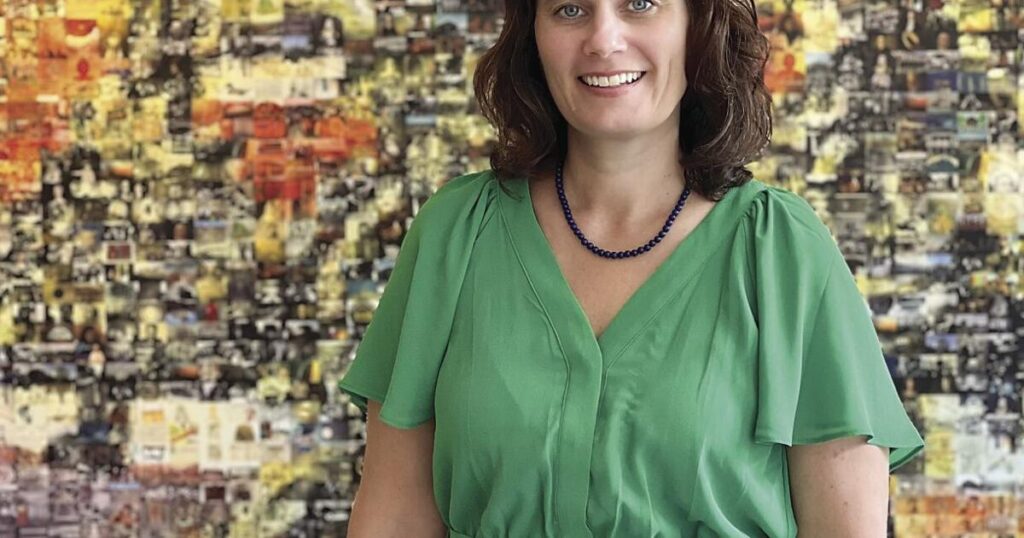Sponsored content
This article is brought to you by Hancock Whitney.
Libby Neidenbach was inspired to further her education when she learned about Marie Couvent, a wealthy free woman of color in New Orleans who donated her fortune to the school. Neidenbach was an undergraduate at Tulane University when she first heard about Couvent, but she primarily attended graduate school to learn more about Couvent’s life and impact. In the process, she learned about other influential women and how they achieved their goals, often while overcoming significant obstacles.
“In graduate school, I thought I would be a professor because that’s what I thought I would do after I got my PhD,” Neidenbach says. “I started working for the National Park Service in Richmond, Virginia. I worked in the home of Maggie Walker, the first African-American woman to be president of a bank in the United States. I was teaching while I was working there, but I wanted to do something other than teaching.”
Niedenbach earned her PhD in American Studies from the College of William and Mary. As she earned her doctorate and envisioned a new career path, she knew she wanted to return to New Orleans, a city she had visited many times with her family as a child and which held a special place in her heart.
“When it came time to choose a college, it was Tulane or no Tulane,” she says, “and then I ended up going to another university, but I always knew I wanted to come back to New Orleans. I love this city. I love the history of this city.”
Niedenbach is currently the associate curator of the Historic New Orleans Collection. She is responsible for managing the items in the collection, adding items through purchases, and researching and creating new exhibits. She has been with the collection for five years and previously worked in visitor services and served as interpretive training coordinator.
Niedenbach looks forward to helping visitors engage with history through the collection’s newest exhibition, “A Carceral State: Louisiana and the Shaping of Mass Incarceration,” which opened July 19 and will run through January 2025. The exhibition explores the connections between slavery and mass incarceration through historical objects, textual interpretation, multimedia and data visualization.
“For the past three years, I’ve been working with visitor services to create special dialogue-based tours,” she said, “which are based on the idea of mutual learning: everyone has experiences and we can learn from each other, especially when talking about complex social issues. For me, it’s really important to make history relevant and help people connect the past with the present.”
Neidenbach said the most impactful work she’s done with the collection so far has been “And Yet She Forged Forward: Women and Voting Rights in New Orleans, 1878-1970,” an exhibition that explores the roles of white and Black women in the women’s suffrage movement and traces how Black women continued to fight for the right to vote even after the 19th Amendment to the federal Constitution gave women the right to vote. The exhibition first took place in a virtual format in 2020, before an expanded, in-person version was shown at the collection last year.
“My office is right next to the gallery, so I can hear people talking all the time as I walk through the exhibition. What’s especially fun is when people say, ‘I didn’t know that,’ or relate the contents of the exhibition to their own lives, like when their grandmother voted for the first time,” says Niedenbach. “Part of the exhibit asked whether voting is the most important right in a democratic society, and we had a book where participants could record their answer and explain why they felt that way. They answered in detail, and you could see the dialogue unfolding in the book. We had nearly 1,000 entries over the course of six months. It’s always great to find a way for visitors to get involved and leave their thoughts as part of the exhibit.”

Niedenbach is a frequent visitor to other museums, exhibitions and historical sites, but was particularly moved by a visit last year to the National Museum of the American Revolution in Philadelphia, Pennsylvania, where an exhibit on the Forten family chronicled their social and business endeavors as free people of color for generations.
“I’m a museum nerd,” Neidenbach says. “I probably owe my passion for history to my grandmothers. My paternal grandmother was an educator and taught me to be curious about the world around me. My maternal grandmother was a true history buff and would take me to museums and historical sites. I also had some great teachers. My AP U.S. History teacher in high school was the first person to really encourage me to consider history as a viable field. I also had some important mentors at Tulane who were really encouraging.”
Niedenbach hopes other women can find similar support in their professional lives, regardless of where their personal passions lie.
“I think it’s really important to have a mentor that you can talk to, that won’t judge you, and that will give you good advice,” she says. “Someone who’s been through a lot more than you can offer a lot of perspective and help you see the bigger picture.”
The “She Is” campaign is a partnership between Hancock Whitney and Georges Media Group to curate and share the stories of successful women – what motivates them, how they inspire others and how women can continue to make an impact. To learn more about Hancock Whitney’s ongoing work with women leaders, visit www.hancockwhitney.com/she-is and share your favorite “She Is” story. Hancock Whitney Bank, Member FDIC


